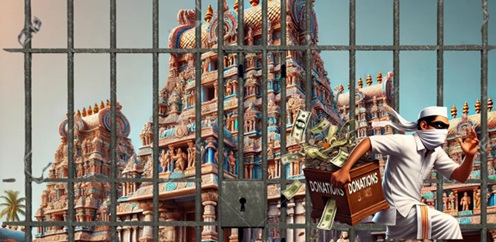| (Mains, General Studies Paper- 1: Salient Features of Indian Society, Diversity of India) |
Context
The recent political controversy in Tamil Nadu over the use of temple funds to build colleges has highlighted a deeper historical and constitutional issue of state regulation of religious endowments and its relation to social justice.

The Tamil Nadu Issue and Current Status
- Temples in Tamil Nadu are governed through the Hindu Religious and Charitable Endowments (HR&CE) Act, 1959.
- It authorises the HR&CE Department to manage temple finances, including endowments.
- Key features of management:
- More than 36,000 temples are under the HR&CE Department.
- The Department also appoints executive officers to administer temple affairs.
Status of other major states apart from Tamil Nadu
Andhra Pradesh
- Tirumala Tirupati Devasthanam (TTD) is one of the richest temple institutions in India. Its income is used for education, health and social service.
- TTD runs colleges, charitable hospitals, free food scheme, Vedic schools etc.
- The state government also controls the income of the temple through the Charity Board.
Karnataka
- The 'Hindu Religious Institutions and Charitable Endowments Department' works under the Karnataka government.
- The state government spends the income of temples on religious works as well as social service (such as scholarships for poor students, Sanskrit education, orphanages) etc.
- There was controversy in the past when a proposal came to run schemes for minority communities from temple funds.
Kerala
- Temples are managed by the state through Devaswom Board (eg- Travancore, Kochi, Malabar Devaswom).
- Schools, hospitals, Sanskrit colleges, social programs are run from the income of temples.
- Example: Schools, libraries and hospitals run by Guruvayur Devaswom Board.
Uttarakhand
- The state passed the Char Dham Devasthanam Board Act in the year 2019, which brought the management of famous temples like Badrinath, Kedarnath under the state.
- However, the government withdrew it in the year 2022 due to controversy, but it is an example of how the state interferes in temple administration.
Tradition of donations to temples
- Evidence of donations to temples starts coming from 970 AD when the Chola Empire was at its peak. During this time, temples continued to receive abundant donations from sovereign rulers.
- Chola queen Sembiyan Mahadevi made strategic donations of land and other goods to temples.
- This practice continued during the Vijayanagara Empire. Temples were not only places of worship but were also socio-cultural centres where they were used for educational purposes as well.
- This is confirmed by inscriptions on temple walls and huge mandapams (pillared halls).
- Hence, ancient evidence also supports the theory of using temple resources for educational purposes.
Historical Background
- 1817 AD: Regulation of Religious Endowments and Escheats introduced state regulation of religious endowments by the East India Company.
- 1858 AD: Proclamation of Queen Victoria assured non-interference in religious practices. However, secular aspects (such as land and wealth) remained subject to regulation.
- British officials in Madras Presidency maintained vigil over the secular aspects of temples while avoiding religious rituals.
Key Legislative Provisions
- 1922: Justice Party introduced the Hindu Religious Endowments Bill, allowing the use of temple surplus funds.
- 1959: Tamil Nadu Hindu Religious and Charitable Endowments (HR&CE) Act legally permitted the use of temple surplus funds for secular welfare, including education (Sections 36 and 66).
- Secular welfare also includes the creation of colleges and universities imparting Hindu religious studies.
- ‘Surplus’ means any amount remaining after adequate provision has been made for the maintenance of the temple and the training of its officials.
Judicial Decisions
- Madras High Court upheld the validity of the use of temple land/funds for the construction of educational institutions and called it a charitable public purpose.
- The 1959 Act was upheld as constitutionally valid, including safeguards to ensure the maintenance of the temple.
Cultural and social perspectives
- Historically temples served as socio-cultural centres, often used for educational purposes (evidence of this in the Chola and Vijayanagara periods).
- The Self-Respect Movement in Tamil Nadu saw temple regulation as essential for anti-caste reforms (such as the Temple Entry Acts of 1936 and 1947).
- Government control has enabled the appointment of priests from backward classes and inclusive reforms.
Significance
- The issue reflects a typical South Indian model of state-regulated secular use of religious resources.
- This is consistent with principles of social justice that enable inclusive welfare through temple wealth.
- Reversing this model could undermine decades of progressive religious and social reform.
Status in other religions
Islam (Waqf property)
- Regulation is done by the state through an independent board.
- Waqf Board has been constituted in every state under the Waqf Act, 1995.
- Waqf properties (cemeteries, madrasas, commercial properties and mosques and dargahs etc.) are administered by the Waqf Board. The Waqf Board is an autonomous body registered under the government.
- The Central Waqf Council supervises it and comes under the Ministry of Minority Affairs.
- The income from Waqf properties can be used by the board for charitable works like establishment of madrasas, schools etc., assistance to the poor. There is no interference of the government in this.
- Mosques and dargahs, donations received in mosques
- In this context, the role of the government is limited to monitoring and administrative control, there is no direct interference.
Christianity (Churches)
- There is no direct regulation by the state.
- Churches are registered as private trusts or societies and operate under the Indian Trust Act, Societies Registration Act and Companies Act (Section 8).
- Their donations and income are used to establish missionary schools, hospitals, orphanages, old age homes etc.
- The state only sees that these organizations are legally registered and follow the rules but does not interfere in their internal funding.
Sikhism (Gurudwaras)
- Some gurdwaras (especially in Punjab, Delhi) come under state acts. E.g.:
- Shiromani Gurdwara Parbandhak Committee constituted under Punjab Gurdwara Act, 1925.
- Delhi Sikh Gurdwara Management Committee under Delhi Act.
- Both of these are autonomous bodies but their elections etc. are subject to state laws.
- Langars, schools, hospitals, orphanages, skill development centres are run from the income of these institutions.
- Here also the government plays a limited regulatory role and there is no direct control.
Conclusion
Despite India having a secular constitution, the state does not interfere equally in the affairs of religious institutions. Particularly in the case of Hindu religious institutions, the state exercises more direct control, while in the cases of other religions, interference is relatively limited.


